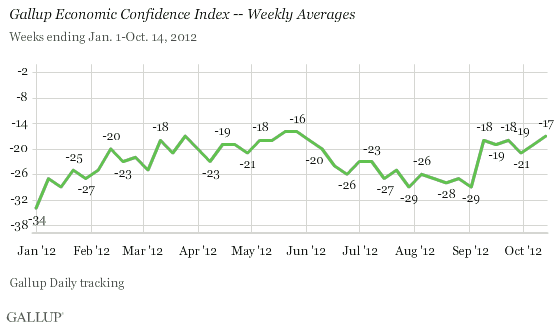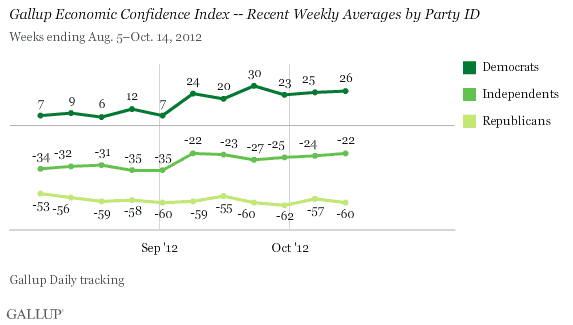WASHINGTON, D.C. -- Americans' economic confidence, on a weekly basis, is now at the highest level Gallup has recorded since late May. The Economic Confidence Index score for the week ending Oct. 14 is -17, up from -19 the week prior and -21 the week prior to that. The current data are the first to include a full week of interviewing after the generally positive Oct. 5 jobs report.

U.S. economic confidence has been substantially higher since the first week of September than it was in the weeks prior to that. With the exception of a slight dip during the week ending Sept. 30, Americans' confidence has been holding at the higher end of what Gallup has found in the post-economic-collapse era.
Americans' views about current economic conditions and the economy going forward improved in the past week. The current economic conditions rating of -23 is the best since early June, reflecting 17% of Americans rating current economic conditions as excellent or good and 40% rating current conditions as poor. The economic outlook rating of -10 reflects 43% of Americans saying the economy is getting better and 53% saying it is getting worse.

The improvement in U.S. economic confidence seen since early September has come almost exclusively among Democrats and independents, and both groups became slightly more positive last week. Republicans remain far more negative, and just as negative as they were before economic confidence surged among Americans on average. As such, it is clear that politics are influencing economic confidence at this point -- perhaps more so than actual economic conditions.

Implications
While Americans on average have become more positive about the economy since early September -- as the University of Michigan Consumer Sentiment Index and the Conference Board have also documented -- this is true only among Democrats and independents. The data suggest that the two groups are either seeing more good news in recent economic reports than Republicans are, or finding other reasons in the current political discourse to become more optimistic.
Whatever the reason, it is important to recognize that the current improvement in economic confidence is inextricably related to the current political climate. This will likely continue to be the case until Election Day and into the coming year, as presidential transitions tend to make the winning party more optimistic about national conditions and the losing party more pessimistic. Nonetheless, the measurable improvement in economic confidence in the final weeks leading up to the election -- combined with higher satisfaction with the way things are going in the country -- is good news for those making the case that the economy is improving and that the nation is on the right track. On the flip side, views remain more negative than positive in an absolute sense, bolstering the case of those arguing for a change in leadership.
Gallup.com reports results from these indexes in daily, weekly, and monthly averages and in Gallup.com stories. Complete trend data are always available to view and export in the following charts:
Daily: Employment, Economic Confidence, Job Creation, Consumer Spending
Weekly: Employment, Economic Confidence, Job Creation, Consumer Spending
Read more about Gallup's economic measures.
View our economic release schedule.
Survey Methods
Results are based on telephone interviews conducted as part of Gallup Daily tracking Oct. 8-14, 2012, with a random sample of 3,416 adults, aged 18 and older, living in all 50 U.S. states and the District of Columbia.
For results based on the total sample of national adults, one can say with 95% confidence that the maximum margin of sampling error is ±2 percentage points.
Interviews are conducted with respondents on landline telephones and cellular phones, with interviews conducted in Spanish for respondents who are primarily Spanish-speaking. Each sample includes a minimum quota of 400 cell phone respondents and 600 landline respondents per 1,000 national adults, with additional minimum quotas among landline respondents by region. Landline telephone numbers are chosen at random among listed telephone numbers. Cell phone numbers are selected using random-digit-dial methods. Landline respondents are chosen at random within each household on the basis of which member had the most recent birthday.
Samples are weighted by gender, age, race, Hispanic ethnicity, education, region, adults in the household, and phone status (cell phone only/landline only/both, cell phone mostly, and having an unlisted landline number). Demographic weighting targets are based on the March 2011 Current Population Survey figures for the aged 18 and older non-institutionalized population living in U.S. telephone households. All reported margins of sampling error include the computed design effects for weighting and sample design.
In addition to sampling error, question wording and practical difficulties in conducting surveys can introduce error or bias into the findings of public opinion polls.
For more details on Gallup's polling methodology, visit www.gallup.com.
